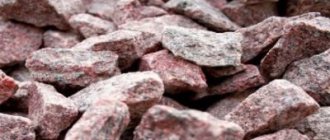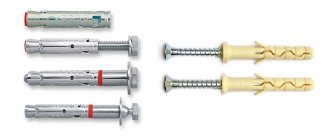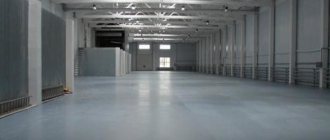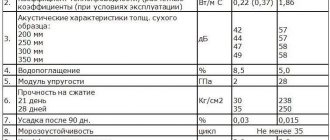In order for concrete to gain strength and not freeze at low air temperatures, it is necessary to observe optimal conditions for its hardening. Heat or severe frosts are not suitable for concreting work. Suitable times are considered to be autumn or spring. What consequences arise if the temperature parameters for pouring concrete are not observed and how to avoid freezing of the structure?
At what temperature does concrete freeze?
For the concrete mixture to harden, the normal temperature is not lower than +5 degrees. Work is usually carried out at air temperatures from +15 to +20 degrees. Compliance with the recommended conditions will avoid the use of additional technologies and avoid unnecessary costs.
Hardening of the base and surface of the concrete structure occurs within a month while maintaining the temperature within +15 - +20 degrees. At temperatures below +15 degrees, the process extends up to 60 days; at zero, hardening stops. The solution poured into the formwork begins to freeze at sub-zero temperatures.
If the foundation managed to get stronger before the onset of cold weather, sudden temperature changes are not scary. In the spring, the suspended process resumes. As a result, the foundation does not freeze or crack. But if the concrete does not have time to gain strength, then during sharp frosts the monolith turns out to be of unsatisfactory quality.
Poured concrete freezes already at -15 degrees. For a strong foundation, such weather is not terrible. Unhardened material freezes at -20 degrees.
What to do if frost strikes after pouring concrete
If after pouring the concrete the weather suddenly changes and frost hits, then the entire structure made from the mixture needs to be warmed up. For these purposes, you can use heat guns and high-power electric spotlights. In addition, to warm up the solution when frost sets in, you can use simple metal barrels with a fire built inside, which should be placed around the perimeter of the structure.
If weather conditions suddenly deteriorate after using the solution, it is recommended to carefully cover the entire structure with PVC film. Thanks to this, the outflow of heat from the upper layers of the grouted structure will be minimized, as well as the thermal regime in its base will be stabilized.
Electric heating is often used to heat the concrete mixture during severe frosts. This method involves the use of electrodes through which current is supplied directly to the concrete. As a result, even if the weather worsens significantly, the solution continues to maintain the temperature required for complete hardening.
What could be the consequences?
Concrete froze while pouring
If during the pouring of the foundation the air temperature drops to sub-zero levels, the following consequences are possible:
- the poured slab does not gain strength;
- even one-time freezing can lead to a decrease in technological strength;
- water accumulates inside the concrete, which turns from a liquid state into ice;
- the surface layer peels off over time, which leads to the appearance of cracks;
- Ice formed in concrete crevices reduces the adhesion of individual components, which also leads to cracks and delamination of the surface.
When the mixture freezes during the pouring process, ice accumulates in the crevices, which inevitably increases in size and creates gaps. This leads to loosening of the monolith and a decrease in strength. As a result, moisture permeability begins to increase. The process of water hydration causes the accumulated liquid to rise to the surface of the concrete. During frosts, the top layer of the slab first cracks.
In the interior of the foundation, heat is generated as a result of a chemical reaction between cement and water. This helps reduce the risk of concrete freezing along the pouring depth.
Concrete frozen after pouring
If the work was carried out in compliance with optimal temperature conditions, but after its completion it became sharply cold outside, then the following consequences are possible:
- With a temporary decrease in temperature, strong deformations inside and on the surface of the poured material do not occur. When the weather returns, the ice accumulated in the concrete thaws. Water does not interfere in any way with the continuation of the hardening process.
Briefly frozen concrete does not lose its original qualities. The only drawback, and not a critical one, is the process of losing the declared brand strength.
- When the air temperature drops sharply, the upper flooded layer suffers. The surface peels off over time due to water rising to the top layer. The fact is that in this case the water-cement ratio is violated: there is a lack of moisture below, and an excess on the surface. When it freezes, water turns into ice, which leads to cracking and damage to the structure.
- If the temperature drops for a long time, the concrete may completely collapse. This is due to the complete stop of the hydration process. Even after a thaw, strength will not be restored. All that remains is to apply additional protective measures during frosts.
Concrete frozen with antifreeze additives
If additional ingredients were added to the solution, but this did not save the situation during severe frosts, then the following consequences are observed:
- When additional additives are used in a concrete mixture, some characteristics of the foundation are reduced, which reduces the strength of the structure. This leads to cracking not only of the top layer, but also of the middle, as well as the base.
- Due to the loss of strength of the concrete structure, deformation occurs.
- Concrete becomes more susceptible to temperature changes than it would be without special antifreeze additives. This leads to the formation of cracks and holes in the base of the structure. When moisture gets into them, gradual destruction occurs.
With antifreeze additives, the likelihood of freezing of the concrete layer is not high. If this does happen, then maintaining the integrity of the structure will be much more difficult.
Basics of winter concreting
Low temperature is a serious obstacle in the process of high-quality concreting. By causing the process of inhibiting the hydration of cement and freezing of water, subzero weather helps to reduce the actual strength gain of concrete up to a complete stop.
If we describe the physical and chemical process, then everything looks approximately as follows. Under normal conditions, concrete needs 5-7 days to gain 70-75% of its final strength. However, already at a temperature of +5 C, the time to gain strength increases 4 times. Due to the reduction in the hydration process, the setting and formation of cement stone is very slow, which is due to the fact that low temperature cannot catalyze this process. That is why, in the manufacture of reinforced concrete products, steaming of freshly cast workpieces is used in special chambers at a temperature of 70-80 C and high humidity.
If a decrease in positive temperature contributes to the regression of the concrete setting process, then its negative values stop it altogether, since the water in young concrete freezes completely.
How then to concrete in winter?
- To do this, it is necessary to solve the main problem - to prevent the water included in the concrete mixture from freezing. To achieve this, modern construction sites use the following techniques:
- Adding antifreeze (anticrystallization) additives to concrete (PMD);
- Electric heating of concrete;
- Installation of temporary structures above concrete, heated by heat guns;
- Covering concrete with PVC film, sawdust and other insulation materials.
Oddly enough, the use of PMD is the most common method of protection against water crystallization in concrete. Moreover, despite the fact that concrete plants already produce products with a similar additive, this method is sometimes combined with electric heating and laying out insulation. PMDs differ from each other in the percentage of additives, which allows you to vary the freezing limit.
Electric heating is popular on serious construction sites, where it is possible to use large power transformers (up to 80 kW). Therefore, for private construction, as a rule, this method is inappropriate due to its inaccessibility and high cost.
Covering concrete with insulation is a rational and inexpensive method at borderline temperatures of +5 C: -5 C. Due to the isothermal nature of the concrete hardening process, it becomes possible to retain the heat generated during the reaction process. To do this, the concrete surface is covered with insulation or PVC film.
Gas and electric heat guns find their use when the temperature drops sharply to -5 C: -15 C. In this case, the insulation layer is laid on PVC film in such a way as to create a canopy of boards over the concrete, which will retain heat. The higher the air temperature in such a “tent”, the faster the process of concrete stone formation will be completed. As a rule, the duration of the warming process with heat guns does not last longer than 3 days.
What to do if the concrete does freeze?
There is no need to worry too much - the isothermal process of strengthening will continue immediately with the arrival of warming, when the crystallized water thaws. As a rule, such a process slightly reduces the performance characteristics of concrete, only slightly reducing the grade strength. That is why, when carrying out concreting work in the cold season, a safety margin is used, selecting more reliable grades of concrete.
However, in cases where a floor slab or foundation slab is poured, the loss of strength can be fatal, especially in cases where the thaw occurs only in the spring. In this case, it is necessary to cover the concrete with PVC film so that during temporary temperature changes the thawed top layer does not collapse. Although this will not save the decline in the strength of concrete, it will at least somehow preserve its strength properties, which, of course, will not be possible to do if things are left to chance.
How long does it take for concrete to not freeze?
The likelihood of concrete freezing depends on the air temperature during pouring and while the structure is gaining strength. If work is carried out at normal temperatures, then it will take at least 2 hours for the foundation to set. The same time will be required for hardening.
At subzero air temperatures, concrete does not gain the required strength. If the temperature drops, the surface will not set and freezing may occur.
The duration of hardening of the structure will depend on the type of concrete mixture used and environmental humidity levels. If the technological operating parameters are observed, complete hardening occurs within 27 - 30 days. After this period there is no fear of frost. In unfavorable weather conditions, the structure may freeze even after 2 months. After 3 - 4 months of setting, frosts are not terrible.
Have you ever poured concrete in freezing temperatures?
Yes
No
Methods of protection against freezing
Air humidity should not exceed 60%.
To prevent freezing, you should:
- do not allow empty space between the plates (to avoid moisture/water);
- material compression – 35%;
- joints must be moisture-repellent and heat-protective (use special mixtures and solutions for their installation);
- adjust the ventilation of the room (to avoid fungus/mold);
- the air temperature on the ground floor should not fall below 0;
- install waterproofing, blind areas, water-repellent devices;
- clean drainage systems 2 times a year;
- if there are areas on the walls affected by moisture and air, immediately dry and clean the room;
- air humidity is not higher than 60%.
If you did not have time to prevent the problem or approached the defense irresponsibly, there is a chance to correct the situation. Start reworking as soon as possible. There are several ways to deal with the freezing problem:
- reduce the overall humidity in the room;
- adjust ventilation according to the norm (no more than 60%);
- adjust the heating system (if the problem is in the central one, call the special services).
Carry out repairs carefully and carefully.
If you miss even one, even an insignificant detail, the overall effect will be poor, the work will be of poor quality, and the work done will need to be repeated again
Return to contents
How to pour concrete in winter and not regret it
There are several ways to avoid problems during winter concreting:
- use branded antifreeze additives - they do not freeze at low temperatures and promote proper hydration of cement;
- cover concrete with films, awnings and other materials to preserve heat;
- warm up the site with heat guns;
- create electrical heating of the foundation.
In order for concrete to really set well and acquire the necessary strength, it is necessary to maintain a positive temperature not only during pouring, but also for at least a month after completion of the work.











